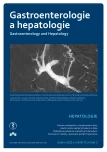Benign asymptomatic pneumoperitoneum in the patient after CT colonography
Authors:
Gerstberger R. 1; Straka M. 1; Pánek J. 1; Kunovsky L. 2,3; Marek F. 3; Bartušek D. 1
Authors‘ workplace:
Klinika radiologie a nukleární medicíny LF MU a FN Brno
1; Interní gastroenterologická klinika LF MU a FN Brno
2; Chirurgická klinika LF MU a FN Brno
3
Published in:
Gastroent Hepatol 2021; 75(2): 165-169
Category:
doi:
https://doi.org/10.48095/ccgh2021165
Overview
Pneumoperitoneum is a condition that refers to the presence of free air (gas) in the abdominal cavity. Differential diagnosis of the causes of pneumoperitoneum varies widely and represents varying degrees of severity. In the patients who have not recently underwent laparotomy or laparoscopy, the finding of pneumoperitoneum is usually a sign of gastrointestinal perforation that requires immediate surgical approach due to the risk of peritonitis with subsequent life-threatening sepsis. However, not all causes of pneumoperitoneum require surgery. In our case report, we present a rare case of clinically asymptomatic pneumoperitoneum that developed in a 66-year-old patient after CT colonography. In this diagnostic method, we inflate colon with carbon dioxide (CO2); therefore this kind of pneumoperitoneum can de facto be called capnoperitoneum. In this patient, free air (gas) in the abdominal cavity manifested itself in the so-called benign pneumoperitoneum, which is defined as asymptomatic free air in the abdominal cavity and pneumoperitoneum without peritonitis. Despite the fact that CT colonography is considered a method with a very low incidence of complications, it is necessary to take into account the presence of risk factors in its indication and to contraindicate to avoid the number of postoperative complications. The fundamental message of our case report is that extensive pneumoperitoneum after proven CT colonography can be asymptomatic and can be treated conservatively (if clinical and laboratory results
are favorable).
Keywords:
CT colonography – pneumoperitoneum – intestinal perforation
Sources
- Ustek S, Boran M, Kismet K. Benign pneumoperitoneum after colonoscopy. Case Rep Med 2010; 2010 : 631036. doi: 10.1155/ 2010/ 631036.
- Paspatis GA, Arvanitakis M, Dumonceau JM et al. Diagnosis and management of iatrogenic endoscopic perforations: European Society of Gastrointestinal Endoscopy (ESGE) Position Statement – Update 2020. Endoscopy 2020; 52(9): 792–810. doi: 10.1055/ a-1222-3191.
- Scalise P, Mantarro A, Pancrazi F et al. Computed tomography colonography for the practicing radiologist: A review of current recommendations on methodology and clinical indications. World J Radiol 2016; 8(5): 472–483. doi: 10.4329/ wjr.v8.i5.472.
- Falt P, Urban O, Suchánek Š et al. Doporučené postupy České gastroenterologické společnosti ČLS JEP pro diagnostickou a terapeutickou koloskopoii. Gastroent Hepatol 2016; 70(6): 523–538. doi: 10.14735/ amgh2016csgh.info19.
- Straková H, Straka L. Postavení CT kolografie v algoritmu vyšetření tlustého střeva. Gastroent Hepatol 2018; 72(1): 66–72. doi: 10.14735/ amgh201866.
- Grega T, Májek O, Ngo O et al. Současné principy screeningu kolorektálního karcinomu – od oportunního k populačnímu screeningovému programu. Gastroent Hepatol 2016; 70(5): 383–392. doi: 10.14735/ amgh2016383.
- Anstis L, Eskandar O. A case report of spontaneous pneumoperitoneum after sexual intercourse following a total laparoscopic hysterectomy, bilateral saplingo-oophorectomy and infra-colic omentectomy. Gynecol Surg 2016; 13 : 211–214. doi: 10.1007/ s10397-016-0947-3.
- Sosna J, Blachar A, Amitai M et al. Colonic perforation at CT colonography: assessment of risk in a multicenter large cohort. Radiology 2006; 239(2): 457–463. doi: 10.1148/ radiol.239 2050287.
- Pickhardt PJ. Incidence of colonic perforation at CT colonography: review of existing data and implications for screening of asymptomatic adults. Radiology 2006; 239(2): 313–316. doi: 10.1148/ radiol.2392052002.
- Bartušek D, Petrášová H. Diagnostika selhání střeva: zobrazovací metody. In: Oliverius M, Kohout P et al. Selhání střeva a transplantace tenkého střeva. 1. vyd. Praha: Mladá fronta 2017 : 98–114.
- Spada C, Stoker J, Alarcon O et al. Clinical indications for computed tomographic colonography: European Society of Gastrointestinal Endoscopy (ESGE) and European Society of Gastrointestinal and Abdominal Radiology (ESGAR) Guideline. Eur Radiol 2015; 25(2): 331–345. doi: 10.1007/ s00330-014-3435-z.
- Spada C, Hassan C, Bellini D et al. Imaging alternatives to colonoscopy: CT colonography and colon capsule. European Society of Gastrointestinal Endoscopy (ESGE) and European Society of Gastrointestinal and Abdominal Radiology (ESGAR) Guideline – Update 2020. Endoscopy 2020; 52(12): 1127–1141. doi: 10.1055/ a-1258-4819.
- Bartušek D, Falt P, Tachecí I et al. Alternativní vyšetření tlustého střeva. In: Falt P, Urban O, Vítek P et al. Koloskopie. Praha: Grada Publishing 2015 : 285–296.
Labels
Paediatric gastroenterology Gastroenterology and hepatology SurgeryArticle was published in
Gastroenterology and Hepatology

2021 Issue 2
Most read in this issue
- Liver injury after the use of anabolic steroids to promote muscle growth – single-center experience
- Teduglutide, a glucagon-like peptide-2 analogue (REVESTIVE), in the treatment of short bowel syndrome with dependence on home parenteral nutrition
- Laparoskopická nebo klasická splenektomie?
- Posuzování funkce ledvin u pacientů s jaterním onemocněním
